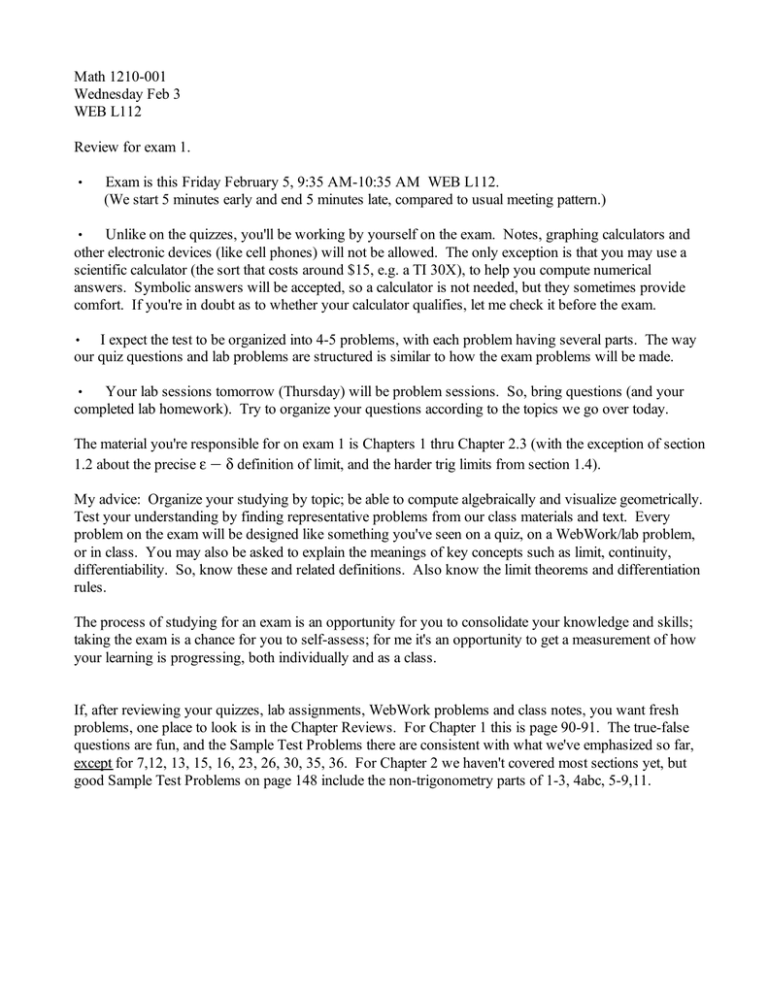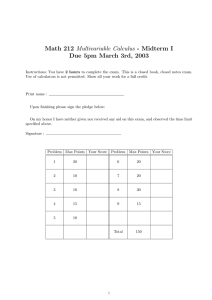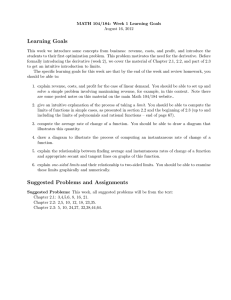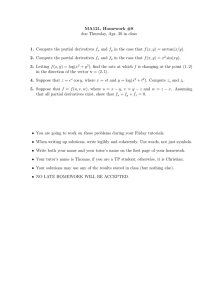Math 1210-001 Wednesday Feb 3 WEB L112 Review for exam 1.
advertisement

Math 1210-001 Wednesday Feb 3 WEB L112 Review for exam 1. , Exam is this Friday February 5, 9:35 AM-10:35 AM WEB L112. (We start 5 minutes early and end 5 minutes late, compared to usual meeting pattern.) , Unlike on the quizzes, you'll be working by yourself on the exam. Notes, graphing calculators and other electronic devices (like cell phones) will not be allowed. The only exception is that you may use a scientific calculator (the sort that costs around $15, e.g. a TI 30X), to help you compute numerical answers. Symbolic answers will be accepted, so a calculator is not needed, but they sometimes provide comfort. If you're in doubt as to whether your calculator qualifies, let me check it before the exam. , I expect the test to be organized into 4-5 problems, with each problem having several parts. The way our quiz questions and lab problems are structured is similar to how the exam problems will be made. , Your lab sessions tomorrow (Thursday) will be problem sessions. So, bring questions (and your completed lab homework). Try to organize your questions according to the topics we go over today. The material you're responsible for on exam 1 is Chapters 1 thru Chapter 2.3 (with the exception of section 1.2 about the precise e K d definition of limit, and the harder trig limits from section 1.4). My advice: Organize your studying by topic; be able to compute algebraically and visualize geometrically. Test your understanding by finding representative problems from our class materials and text. Every problem on the exam will be designed like something you've seen on a quiz, on a WebWork/lab problem, or in class. You may also be asked to explain the meanings of key concepts such as limit, continuity, differentiability. So, know these and related definitions. Also know the limit theorems and differentiation rules. The process of studying for an exam is an opportunity for you to consolidate your knowledge and skills; taking the exam is a chance for you to self-assess; for me it's an opportunity to get a measurement of how your learning is progressing, both individually and as a class. If, after reviewing your quizzes, lab assignments, WebWork problems and class notes, you want fresh problems, one place to look is in the Chapter Reviews. For Chapter 1 this is page 90-91. The true-false questions are fun, and the Sample Test Problems there are consistent with what we've emphasized so far, except for 7,12, 13, 15, 16, 23, 26, 30, 35, 36. For Chapter 2 we haven't covered most sections yet, but good Sample Test Problems on page 148 include the non-trigonometry parts of 1-3, 4abc, 5-9,11. Chapter 1: Limits. 1a) What is the definition of lim f x = L ? x/c (Can you explain it in words?) 1b) Can you further explain the meaning of the limit statement with a picture, using the graph of f or some other representation? 1c) Can you compute limits (or deduce that they DNE) if f x is given algebraically, or if you're shown a graph of f ? 1d) What theorems do you know that help you compute limits? (This relates to 1c.) 1e) What are one-sided limits? Are you able to compute them from algebraic formulas or deduce them from graphs of functions? 1f) What are the possible limits involving N? Can you compute them? Review 1) Consider the function f x = x2 K 4 x2 C x K 6 . Find the following limits, or write DNE if they do not exist as a finite number. In that case consider possible infinite limits. Show reasoning. a) xlim f x /0 b) lim f x x/2 c) xlim f x /N d) lim x /K3 C f x e) Discuss vertical and horizontal asymptotes to the graph of f. Limits and continuity ... 1g) What is the definition of the function f x being continuous at x = c ? 1h) What does continuity at x = c mean geometrically, i.e. in terms of the graph of f? 1i) Can you check whether functions are continuous at a given point, or on an interval, using formulas for the functions? In terms of properties of the graph? 1j) What theorems help you check continuity? Review 2) Where is the function f defined in Review 1 discontinuous? are any of the discontinuities removable? Chapter 2.1-2.3 Derivatives. 2a) For a function f defined on an interval a, b what is the average rate of change of f on that inteval, defined algebraically? What does it represent geometrically, in terms of the graph of f ? 2b) If c is an interior point to that interval, what is the instantaneous rate of change of f at c ? What does it represent geometrically, in terms of the graph of f ? 2c) How are the units of average rate of change and instantaneous rate of change related to the units of the input "x" and the output "f x "? What sorts of applied examples have we considered? 2d) What is the derivative, f# c , i.e. the limit definition. Can you recognize equivalent formulations? Review 3) Consider the function xC2 1 = 1K xC3 xC3 which is related to the function f we considered earlier. a) What is the average rate of change of g on the interval K2, 0 ? g x = b) Write a limit expression for the instantaneous rate of change of g at x =K2? 2e) Can you determine whether a function is differentiable at a point from graphical and/or algebraic information? 2f) How are continuity and differentiability related? 2g) Can you compute derivatives using the limit definition of derivative? 2h) Can you compute derivatives using the derivative rules of section 2.3? Do you have the rules memorized? Review 4) a) For what x is the g defined earlier differentiable? What is the formula for the derivative at those xvalues? (Use derivative rules.) b) Use the limit definition of derivative to recompute g# x . 2i) Can you find tangent lines to graphs of functions, tangent to the graph at specified points, using derivatives? 2j) Can you answer questions related to position functions and velocity, (and other functions and their time rates of change) like those we've seen in class and in lab and WebWork problems? Review 5) What is the equation of the tangent line to the graph of g at x =K2 ? 3 2 1 K2 K1 x 0 K1 1


